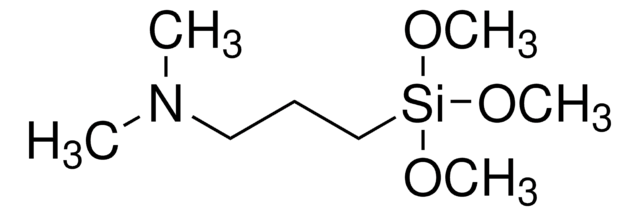440809
N-[3-(Trimethoxysilyl)propyl]aniline
Synonyme(s) :
Trimethoxy[3-(phenylamino)propyl]silane, (3-Anilinopropyl)trimethoxysilane, N-[3-(Trimethoxysilyl)propyl]aniline, [3-(Phenylamino)propyl]trimethoxysilane
About This Item
Produits recommandés
Forme
liquid
Niveau de qualité
Indice de réfraction
n20/D 1.506 (lit.)
pb
310 °C (lit.)
Densité
1.07 g/mL at 25 °C (lit.)
Chaîne SMILES
CO[Si](CCCNc1ccccc1)(OC)OC
InChI
1S/C12H21NO3Si/c1-14-17(15-2,16-3)11-7-10-13-12-8-5-4-6-9-12/h4-6,8-9,13H,7,10-11H2,1-3H3
Clé InChI
KBJFYLLAMSZSOG-UHFFFAOYSA-N
Vous recherchez des produits similaires ? Visite Guide de comparaison des produits
Catégories apparentées
Description générale
Application
Mention d'avertissement
Danger
Mentions de danger
Classification des risques
Aquatic Chronic 3 - Carc. 2 - Eye Dam. 1 - Muta. 2 - Skin Corr. 1B - Skin Sens. 1 - STOT RE 1
Organes cibles
Blood
Code de la classe de stockage
6.1C - Combustible acute toxic Cat.3 / toxic compounds or compounds which causing chronic effects
Classe de danger pour l'eau (WGK)
WGK 2
Point d'éclair (°F)
230.0 °F - closed cup
Point d'éclair (°C)
110 °C - closed cup
Faites votre choix parmi les versions les plus récentes :
Déjà en possession de ce produit ?
Retrouvez la documentation relative aux produits que vous avez récemment achetés dans la Bibliothèque de documents.
Les clients ont également consulté
Global Trade Item Number
| Référence | GTIN |
|---|---|
| 440809-250ML | |
| 440809-50ML | 4061832253473 |
Notre équipe de scientifiques dispose d'une expérience dans tous les secteurs de la recherche, notamment en sciences de la vie, science des matériaux, synthèse chimique, chromatographie, analyse et dans de nombreux autres domaines..
Contacter notre Service technique






![Trimethoxy[3-(methylamino)propyl]silane 95%](/deepweb/assets/sigmaaldrich/product/structures/236/724/a4aa90e7-bf25-425f-9e44-cbc87ffac9fd/640/a4aa90e7-bf25-425f-9e44-cbc87ffac9fd.png)




